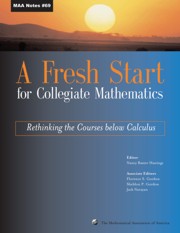Book contents
- Frontmatter
- Preface
- Contents
- Introduction
- Background
- 3 Who are the Students Who Take Precalculus?
- 4 Enrollment Flow to and from Courses Below Calculus
- 5 What Have We Learned from Calculus Reform? The Road to Conceptual Understanding
- 6 Calculus and Introductory College Mathematics: Current Trends and Future Directions
- Theme 1 New Visions for Introductory Collegiate Mathematics
- Theme 2 The Transition from High School to College
- Theme 3 The Needs of Other Disciplines
- Theme 4 Student Learning and Research
- Theme 5 Implementation
- Theme 6 Influencing the Mathematics Community
- Ideas and Projects that Work: Part 1
- Ideas and Projects that Work: Part 2
5 - What Have We Learned from Calculus Reform? The Road to Conceptual Understanding
from Background
- Frontmatter
- Preface
- Contents
- Introduction
- Background
- 3 Who are the Students Who Take Precalculus?
- 4 Enrollment Flow to and from Courses Below Calculus
- 5 What Have We Learned from Calculus Reform? The Road to Conceptual Understanding
- 6 Calculus and Introductory College Mathematics: Current Trends and Future Directions
- Theme 1 New Visions for Introductory Collegiate Mathematics
- Theme 2 The Transition from High School to College
- Theme 3 The Needs of Other Disciplines
- Theme 4 Student Learning and Research
- Theme 5 Implementation
- Theme 6 Influencing the Mathematics Community
- Ideas and Projects that Work: Part 1
- Ideas and Projects that Work: Part 2
Summary
Goals
In order to evaluate the impact of calculus reform, we first need to recall its goals. Although different people may phrase it differently, everyone involved would agree that they were trying to improve the teaching of calculus. Some would say they wanted more student involvement; others would say they wanted to take advantage of technology; others would say they wanted to emphasize problem solving and modeling. Most would agree that they wanted to improve conceptual understanding. What has been the impact of this effort?
Background to calculus reform: Rationale for change
The teaching of calculus came under scrutiny in the 1980s for several reasons. One was concern over the students' apparent lack of understanding of the subject, especially when asked to use it in an unfamiliar situation. Faculty outside mathematics frequently complained that students could not apply the concepts they had been taught. In some instances, ideas were being used in other fields in ways that were sufficiently different from the way they are used in mathematics that it was not surprising that students did not make the connection. For example, the minimization of average cost was done symbolically in mathematics, if at all, whereas it is usually done graphically in economics.
However, students also had difficulty recognizing mathematical ideas that were presented the same way as in mathematics. A small difference in notation or the absence of familiar clues—such as “largest” or “smallest” in an optimization problem—easily threw students off. This striking difficulty in transferring knowledge between fields suggested that students' understanding was not sufficiently robust.
- Type
- Chapter
- Information
- A Fresh Start for Collegiate MathematicsRethinking the Courses below Calculus, pp. 43 - 45Publisher: Mathematical Association of AmericaPrint publication year: 2006
- 7
- Cited by

